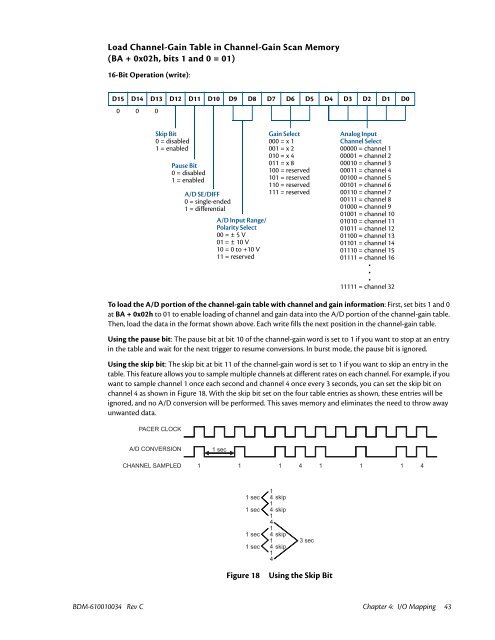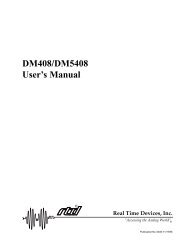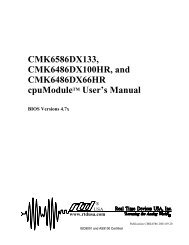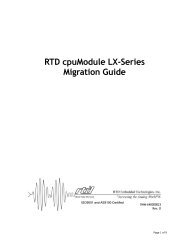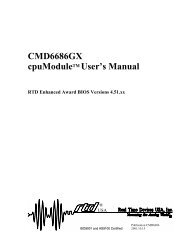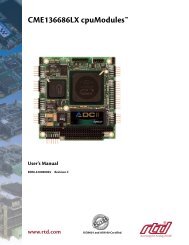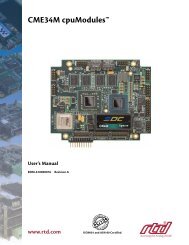Hardware Manual - RTD Embedded Technologies, Inc.
Hardware Manual - RTD Embedded Technologies, Inc.
Hardware Manual - RTD Embedded Technologies, Inc.
Create successful ePaper yourself
Turn your PDF publications into a flip-book with our unique Google optimized e-Paper software.
Load Channel-Gain Table in Channel-Gain Scan Memory<br />
(BA + 0x02h, bits 1 and 0 = 01)<br />
16-Bit Operation (write):<br />
D15 D14 D13 D12 D11 D10 D9 D8 D7 D6 D5 D4 D3 D2 D1 D0<br />
0 0 0<br />
Skip Bit<br />
0 = disabled<br />
1 = enabled<br />
Pause Bit<br />
0 = disabled<br />
1 = enabled<br />
A/D SE/DIFF<br />
0 = single-ended<br />
1 = differential<br />
A/D Input Range/<br />
Polarity Select<br />
00 = ± 5 V<br />
01 = ± 10 V<br />
10 = 0 to +10 V<br />
11 = reserved<br />
Gain Select<br />
000 = x 1<br />
001 = x 2<br />
010 = x 4<br />
011 = x 8<br />
100 = reserved<br />
101 = reserved<br />
110 = reserved<br />
111 = reserved<br />
Analog Input<br />
Channel Select<br />
00000 = channel 1<br />
00001 = channel 2<br />
00010 = channel 3<br />
00011 = channel 4<br />
00100 = channel 5<br />
00101 = channel 6<br />
00110 = channel 7<br />
00111 = channel 8<br />
01000 = channel 9<br />
01001 = channel 10<br />
01010 = channel 11<br />
01011 = channel 12<br />
01100 = channel 13<br />
01101 = channel 14<br />
01110 = channel 15<br />
01111 = channel 16<br />
•<br />
•<br />
•<br />
11111 = channel 32<br />
To load the A/D portion of the channel-gain table with channel and gain information: First, set bits 1 and 0<br />
at BA + 0x02h to 01 to enable loading of channel and gain data into the A/D portion of the channel-gain table.<br />
Then, load the data in the format shown above. Each write fills the next position in the channel-gain table.<br />
Using the pause bit: The pause bit at bit 10 of the channel-gain word is set to 1 if you want to stop at an entry<br />
in the table and wait for the next trigger to resume conversions. In burst mode, the pause bit is ignored.<br />
Using the skip bit: The skip bit at bit 11 of the channel-gain word is set to 1 if you want to skip an entry in the<br />
table. This feature allows you to sample multiple channels at different rates on each channel. For example, if you<br />
want to sample channel 1 once each second and channel 4 once every 3 seconds, you can set the skip bit on<br />
channel 4 as shown in Figure 18. With the skip bit set on the four table entries as shown, these entries will be<br />
ignored, and no A/D conversion will be performed. This saves memory and eliminates the need to throw away<br />
unwanted data.<br />
PACER CLOCK<br />
A/D CONVERSION<br />
CHANNEL SAMPLED<br />
1 sec<br />
1 1 1 4 1 1 1 4<br />
1 sec<br />
1 sec<br />
1 sec<br />
1 sec<br />
1<br />
4 skip<br />
1<br />
4 skip<br />
1<br />
4<br />
1<br />
4 skip<br />
1<br />
4 skip<br />
1<br />
4<br />
3 sec<br />
Figure 18<br />
Using the Skip Bit<br />
BDM-610010034 Rev C Chapter 4: I/O Mapping 43


